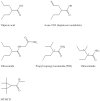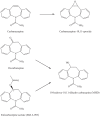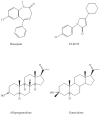Modifications of antiepileptic drugs for improved tolerability and efficacy
- PMID: 19787095
- PMCID: PMC2746576
Modifications of antiepileptic drugs for improved tolerability and efficacy
Abstract
Introduction: A large number of antiepileptic drugs (AEDs) are available today, but they may not be satisfactory regarding clinical efficacy, tolerance, toxicity or pharmacokinetic properties. The purpose of this review is to focus upon the rationale behind the chemical modifications of several recently marketed AEDs or drugs in development and to categorize them according to the main purposes for the improvements: better efficacy or tolerability accompanied by improved pharmacokinetic properties.
Material and method: AEDs that have been chemically modified to new derivatives during the last years are reviewed based on recent publications and PubMed-searches.
Results and discussion: Improvement in pharmacokinetic parameters may affect both tolerability and efficacy. Modifications to improve tolerability include various valproate analogues, divided into aliphatic amides, cyclic derivatives or amino acid conjugates. Furthermore, there are the carbamazepine analogues oxcarbazepine and eslicarbazepine, the felbamate analogues fluorofelbamate and carisbamate (RWJ 33369), and the lamotrigine analogue JZP-4. The levetiracetam analogues brivaracetam and seletracetam and the derivatives of gabapentin, pregabalin and XP13512, have improved selectivity compared to their parent compounds. Other new drugs have new mechanisms of action related to GABA and glutamate receptors; the glutamate antagonists like topiramate (talampanel and NS-1209), and GABA(A) receptor agonists, benzodiazepine or progesterone analogues (ELB-139 and ganaxolone).
Conclusion: Further challenges for development of new AEDs include investigations of target molecules affected by pathophysiological processes and detailed structure-activity relationships with focus on stereoselectivity. These potential drugs may become of importance in future drug therapy in epilepsy and other CNS disorders.
Keywords: antiepileptic drugs; chemical modification; efficacy; monitoring; pharmacodynamics; pharmacokinetics; tolerability.
Figures











Similar articles
-
New antiepileptic drugs that are second generation to existing antiepileptic drugs.Expert Opin Investig Drugs. 2006 Jun;15(6):637-47. doi: 10.1517/13543784.15.6.637. Expert Opin Investig Drugs. 2006. PMID: 16732716 Review.
-
Progress report on new antiepileptic drugs: a summary of the Eigth Eilat Conference (EILAT VIII).Epilepsy Res. 2007 Jan;73(1):1-52. doi: 10.1016/j.eplepsyres.2006.10.008. Epub 2006 Dec 8. Epilepsy Res. 2007. PMID: 17158031
-
Pharmacological management of epilepsy: recent advances and future prospects.Drugs. 2008;68(14):1925-39. doi: 10.2165/00003495-200868140-00001. Drugs. 2008. PMID: 18778117 Review.
-
Pharmacokinetic variability of newer antiepileptic drugs: when is monitoring needed?Clin Pharmacokinet. 2006;45(11):1061-75. doi: 10.2165/00003088-200645110-00002. Clin Pharmacokinet. 2006. PMID: 17048972 Review.
-
Drug interactions involving the new second- and third-generation antiepileptic drugs.Expert Rev Neurother. 2010 Jan;10(1):119-40. doi: 10.1586/ern.09.136. Expert Rev Neurother. 2010. PMID: 20021326 Review.
Cited by
-
Anticancer mechanisms of Strobilanthes crispa Blume hexane extract on liver and breast cancer cell lines.Oncol Lett. 2017 Oct;14(4):4957-4964. doi: 10.3892/ol.2017.6821. Epub 2017 Aug 24. Oncol Lett. 2017. PMID: 29085507 Free PMC article.
-
Antiepileptic drug interactions - principles and clinical implications.Curr Neuropharmacol. 2010 Sep;8(3):254-67. doi: 10.2174/157015910792246254. Curr Neuropharmacol. 2010. PMID: 21358975 Free PMC article.
-
Antiseizure Medications: Advancements, Challenges, and Prospects in Drug Development.Curr Neuropharmacol. 2025;23(8):879-906. doi: 10.2174/011570159X323666241029171256. Curr Neuropharmacol. 2025. PMID: 39865817 Free PMC article. Review.
-
Phenotypic screening in the 21st century.Front Pharmacol. 2014 Dec 1;5:264. doi: 10.3389/fphar.2014.00264. eCollection 2014. Front Pharmacol. 2014. PMID: 25520660 Free PMC article. No abstract available.
-
Comparative pharmacokinetics of valproic acid among Pakistani and South Korean patients: A population pharmacokinetic study.PLoS One. 2022 Aug 24;17(8):e0272622. doi: 10.1371/journal.pone.0272622. eCollection 2022. PLoS One. 2022. PMID: 36001534 Free PMC article.
References
-
- Ahmad S, Fowler LJ, Whitton PS. Lamotrigine, carbamazepine and phenytoin differentially alter extracellular levels of 5-hydroxytryptamine, dopamine and amino acids. Epilepsy Res. 2005;63:141–9. - PubMed
-
- Aldenkamp A, Vigevano F, Arzimanoglou A, et al. Role of valproate across the ages. Treatment of epilepsy in children. Acta. Neurol. Scand. 2006;114(suppl 184):1–13. - PubMed
-
- Anmann B, Grünze H, Vieta E, et al. Antiepileptic drugs and mood stability. Clin. EEG Neurosci. 2007;38:116–23. - PubMed
-
- Anmann B, Grünze H. Neurochemical underpinnings in bipolar disorder and epilepsy. Epilepsia. 2005;46:26–30. - PubMed
-
- Bailie T. Metabolism of valproate to heaptotoxic intermediates. Pharm. Weekbl. Sci. 1992;14:122–5. - PubMed
LinkOut - more resources
Full Text Sources
Other Literature Sources
Miscellaneous
